Transform Your Old China Cabinet: The Ultimate Guide to DIY Makeovers & Repurposing Ideas
Do you have an outdated china cabinet gathering dust in your dining room, feeling like a relic from another era? This classic piece of furniture holds incredible potential far beyond its original purpose of displaying formal dishes. Instead of letting it take up valuable space, imagine transforming it into a stunning, functional focal point that perfectly complements your modern home aesthetic and meets your current needs.
A china cabinet makeover offers a fantastic opportunity to breathe new life into an heirloom, a thrift store find, or a forgotten piece. Whether you dream of a simple refresh with a fresh coat of paint and elegant new hardware, or a complete repurpose into a chic coffee station, a sophisticated home bar, a stylish craft supply center, or a unique display case, the rewards are significant for a surprisingly modest investment of time and resources.
This comprehensive guide will walk you through every step of the process, from initial planning and essential preparation to a wealth of creative design ideas and detailed, easy-to-follow instructions. Get ready to embark on a satisfying weekend project that will elevate your home decor, personalize your space, and unleash the hidden potential of your beloved china cabinet.
Why Invest in a China Cabinet Makeover?
For too long, the traditional china cabinet has been relegated to the sidelines, often looking out of place and unused in modern dining rooms. However, its robust construction and generous storage space make it an ideal candidate for a creative overhaul. Transforming your china cabinet isn’t just about updating an old piece; it’s about revitalizing an entire room, embracing sustainable home decor practices, and creating a truly unique item.
Boost Your Home’s Aesthetics and Style
A simple yet impactful china cabinet makeover can dramatically alter the ambiance of any room. By applying a fresh coat of paint, updating the hardware, or incorporating innovative glass treatments, you can seamlessly integrate an antique or vintage piece into your contemporary home design. Imagine a light, airy color opening up a small space, or a rich, dark hue adding a sophisticated touch of warmth and character. This personalized touch allows your cabinet to become a statement piece that reflects your personality, rather than just overlooked storage.
Unleash New Functionality and Save Money
Beyond its traditional role, a sturdy china cabinet boasts incredible versatility. Modern homeowners are discovering countless new applications for these elegant pieces. Envision transforming your outdated cabinet into a highly organized coffee station, a fully stocked home bar, a dedicated craft supply center, a stylish bookshelf, a practical mudroom organizer, or even a sophisticated office storage unit. Customizing internal shelving, adding practical drawers, or installing ambient lighting can dramatically enhance its utility for your everyday needs, making it a truly indispensable piece of furniture.
Furthermore, the cost-effectiveness of a DIY china cabinet makeover is undeniable. Acquiring new, high-quality furniture can be a significant financial undertaking. By contrast, repurposing and updating an existing china cabinet typically costs a fraction of buying a new storage solution of comparable size and craftsmanship. With a modest investment in materials and a rewarding weekend project, you can achieve a custom, bespoke piece that would otherwise cost hundreds, if not thousands, more if purchased brand new. It’s an eco-friendly choice that saves money, reduces waste, and delivers unique style that’s truly yours.
Key Considerations Before Embarking on Your China Cabinet Makeover
A successful china cabinet transformation begins with careful planning. Taking the time to evaluate and strategize beforehand will undoubtedly save you from wasted effort, unexpected costs, and common DIY frustrations. This foundational preparation ensures your project runs smoothly and yields the beautiful, lasting results you envision.
Thoroughly Assessing the Cabinet’s Condition
Before any brushes touch the surface, conduct a meticulous inspection of your china cabinet. Scrutinize every detail for structural weaknesses or cosmetic damage. Look for signs of loose joints, unstable legs, cracked or broken glass panels, and any areas of chipped, scratched, or water-damaged wood. Addressing these foundational issues is paramount; small repairs, like gluing loose joints, reinforcing wobbly legs, or filling minor dents with wood filler, should always precede any painting or finishing work.
Furthermore, test all drawers and doors to ensure they glide open and close effortlessly. If mechanisms are stiff, misaligned, or sticky, identify the cause – it could be swollen wood, worn runners, or faulty hinges. Serious structural damage might require professional attention or prompt you to reconsider the viability of the project, weighing the effort against the potential outcome. A solid and stable foundation is absolutely key to a lasting and satisfying china cabinet makeover.
Selecting the Right Materials for Lasting Beauty
Your choice of materials will profoundly influence both the final aesthetic and the durability of your repurposed china cabinet. When it comes to paint, invest in high-quality furniture-grade options. Oil-based paints are renowned for their superior durability and chip resistance, making them ideal for high-traffic pieces, though they require mineral spirits for cleanup. Water-based (latex or acrylic) paints are typically easier to work with, dry faster, and clean up with water, offering excellent results for most home projects with good adhesion and finish.
If you prefer to highlight the natural beauty of the wood, a quality wood stain can bring out the grain and add depth, followed by a durable protective topcoat. Don’t underestimate the transformative power of new hardware: stylish handles, knobs, and hinges can instantly update the cabinet’s look with minimal effort and cost. Explore various glass options too; clear glass maintains transparency, frosted glass offers a degree of privacy, and patterned or reeded glass can introduce intriguing texture and visual interest, completely altering the cabinet’s character and light diffusion.
Defining Your Cabinet’s New Style and Purpose
Clarity on how your reimagined china cabinet will function is crucial for guiding your design choices. Will it remain primarily a display piece, or will it serve a new, practical storage role? If you’re envisioning a dedicated coffee station, you’ll need to plan for specific shelving heights to accommodate appliances, mugs, and supplies, potentially even adding a power strip. For a sophisticated home bar, consider integrating wine glass racks, bottle dividers, or a pull-out shelf for mixing cocktails. Every functional decision should inform your aesthetic plan, ensuring the cabinet is both beautiful and practical.
Equally important is considering your home’s existing decor style. A rustic farmhouse aesthetic might call for distressed paint finishes, natural wood accents, and vintage-inspired hardware. Conversely, a minimalist or modern home might suit a sleek, monochromatic paint job with clean lines and contemporary metal pulls. Ensure your china cabinet makeover enhances, rather than clashes with, your overall interior design theme, creating a cohesive and harmonious living space that feels intentional and stylish.
Inspiring Creative Ideas for Your China Cabinet Makeover
The inherent structure of a china cabinet makes it a versatile canvas for a myriad of creative transformations. Whether your taste leans towards rustic charm, modern minimalism, or vibrant eccentricity, there’s a makeover style perfectly suited to your personal expression and home decor needs. These popular approaches will guide you in upgrading your cherished, or forgotten, piece into a fresh, functional, and truly eye-catching addition to any room.
1. Modern Farmhouse Charm
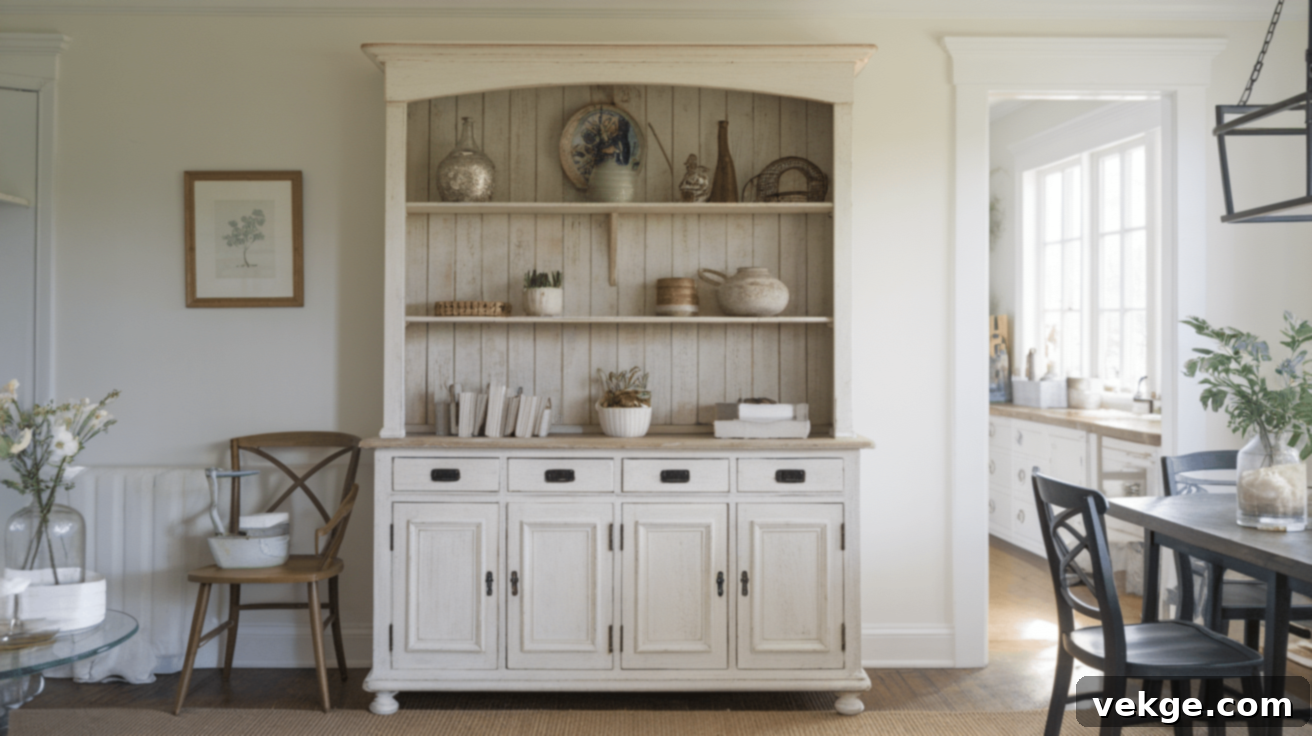
Infuse your home with the warm, inviting appeal of a modern farmhouse aesthetic. This style typically involves painting the main body of the china cabinet in a soft, neutral color like antique white, light grey, or sage green, while selectively preserving or staining certain wood elements (like the top surface or interior backing) to highlight natural textures. Complement this with simple, matte black or oil-rubbed bronze hardware for a striking, yet understated contrast. For an even more open and inviting feel, consider removing some or all of the upper cabinet doors to create exposed shelving, perfect for displaying curated everyday items, cherished ceramics, or decorative plants. This versatile look blends effortlessly into various home settings, bringing a sense of comfort and timeless elegance to your dining room or kitchen.
2. Dedicated Coffee & Beverage Station
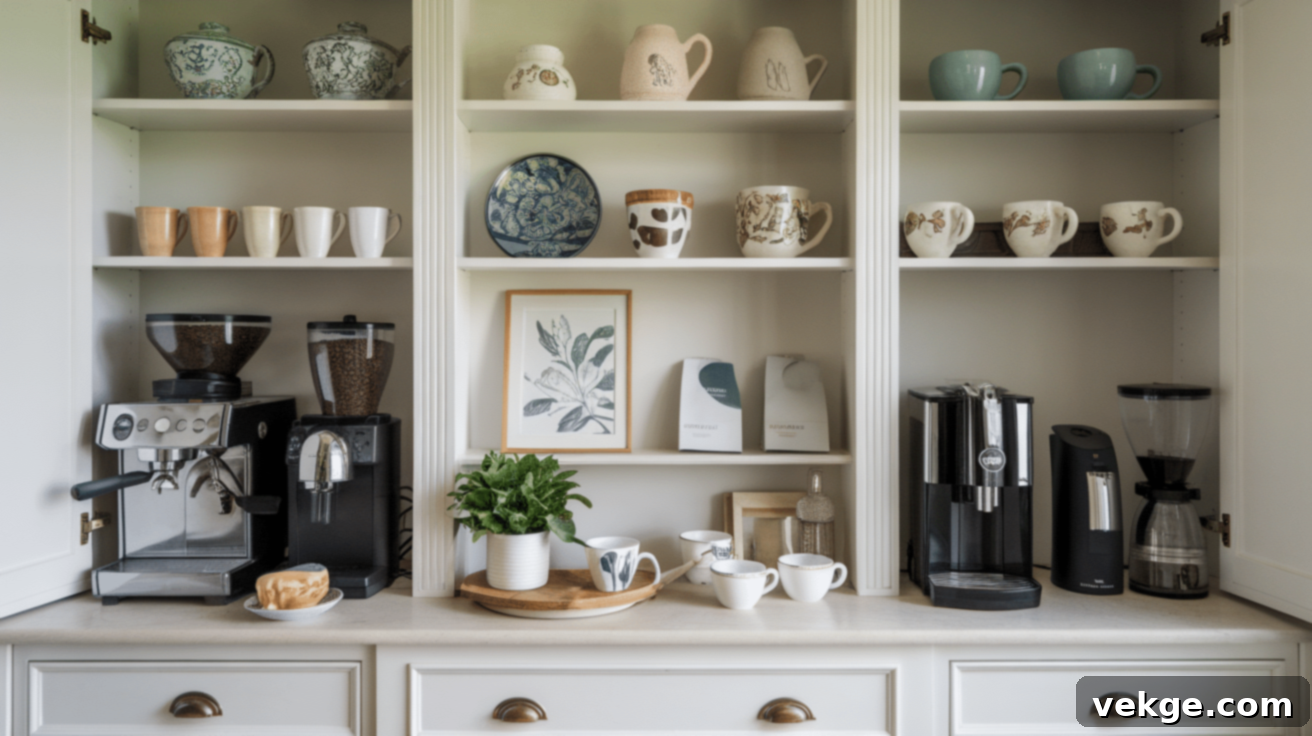
Elevate your morning routine by transforming your china cabinet into a highly organized and stylish coffee station – a trend that has rapidly gained popularity in home design. Begin by adjusting or removing internal shelves to perfectly accommodate your coffee maker, espresso machine, and grinder. Install practical hooks underneath the upper cabinet sections for easy access to mugs and teacups. Incorporate small drawers, decorative bins, or wicker baskets within the lower section to neatly store coffee pods, filters, stirrers, and various tea supplies. The glass display areas are ideal for showcasing your favorite collection of pretty mugs, artisanal coffee beans, or special tea blends, making every coffee break a more pleasant and visually appealing experience. You might even consider adding a power strip discreetly inside for ultimate convenience and a truly functional beverage hub.
3. Sophisticated Home Bar Cabinet
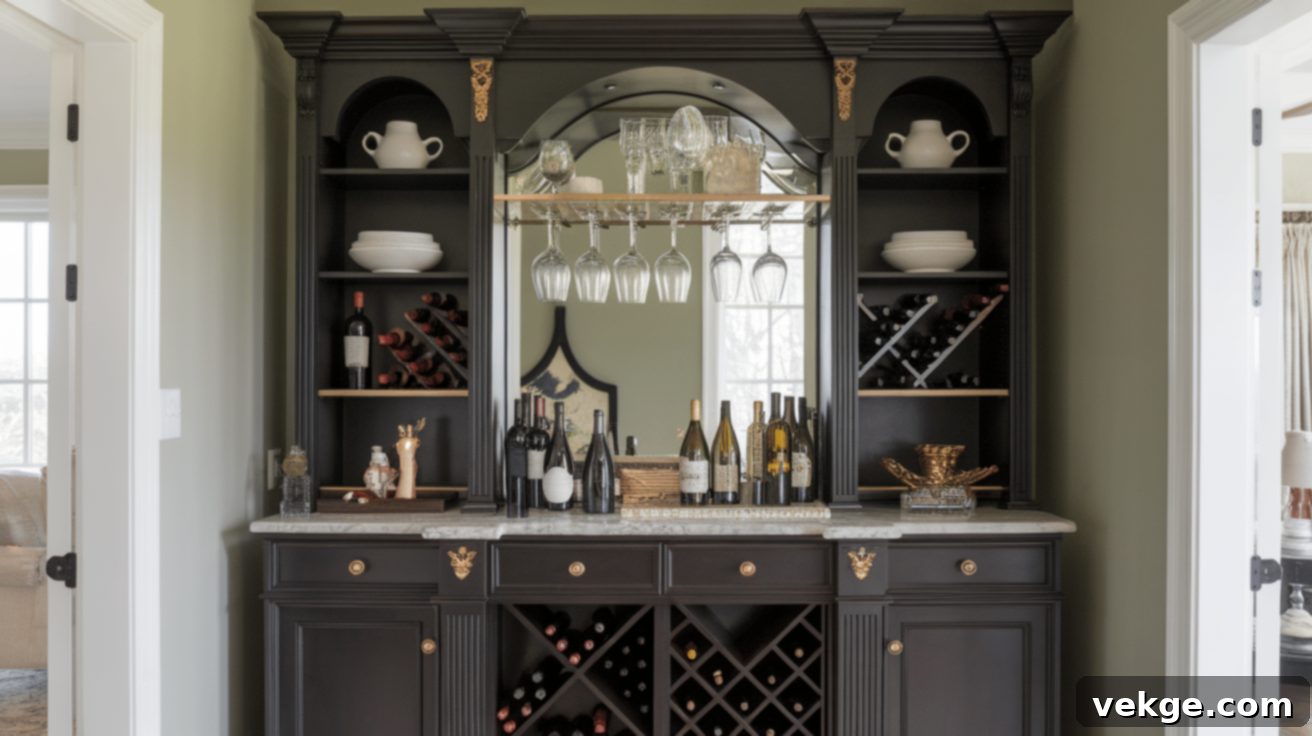
With a few strategic modifications, a traditional china cabinet can be reimagined as an impressive and highly functional home bar. The enclosed lower storage compartments are perfect for discreetly stowing bottles of spirits, wines, and mixers, while the upper display areas provide an elegant stage for showcasing your finest glassware, unique decanters, or treasured cocktail recipe books. Enhance functionality by adding a small pull-out shelf, ideal for mixing drinks without cluttering your countertop. Wine glass racks can be easily installed on the underside of shelves, keeping stemware organized and within reach. Opt for rich, deep paint colors like navy blue, forest green, or charcoal grey, combined with metallic hardware (brass or gold) to evoke a cozy, luxurious, lounge-like atmosphere, perfect for entertaining guests or enjoying a quiet evening drink.
4. Embracing a Vintage Antique Aesthetic
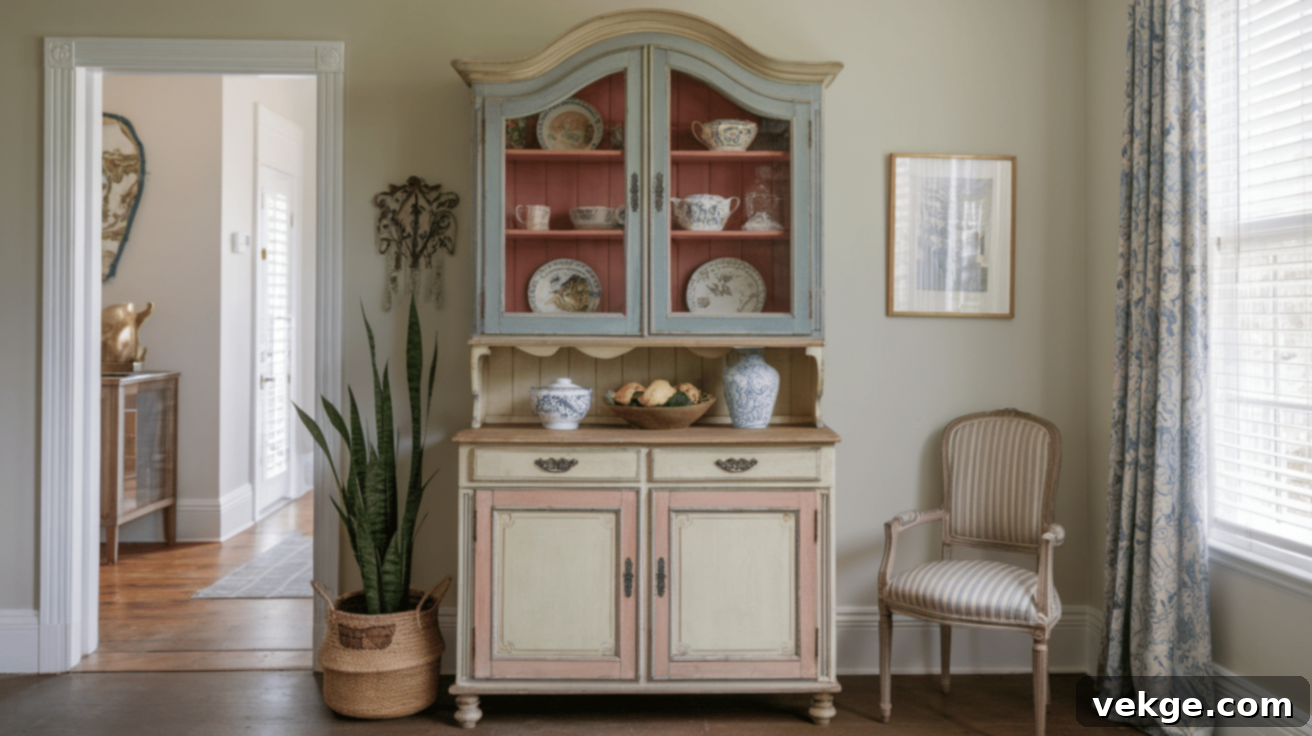
Celebrate the inherent charm and history of older cabinets by employing techniques that highlight their age and character. Achieve an authentic distressed finish by applying multiple layers of complementary paint colors, allowing a hint of the undercoat to show through as you lightly sand certain areas, particularly edges and corners. This creates a beautifully aged, worn-in look that tells a story. A soft, clear, or tinted wax finish will not only add a subtle sheen but also provide essential protection for the painted surface, deepening its allure and enhancing its vintage feel. Consider retaining the cabinet’s original hardware if it’s in good condition, or hunt for unique, period-appropriate replacements at antique shops, flea markets, or online marketplaces. This style reveres the cabinet’s past while granting it a renewed, romantic appeal.
5. Effortless Chalk Paint Makeover
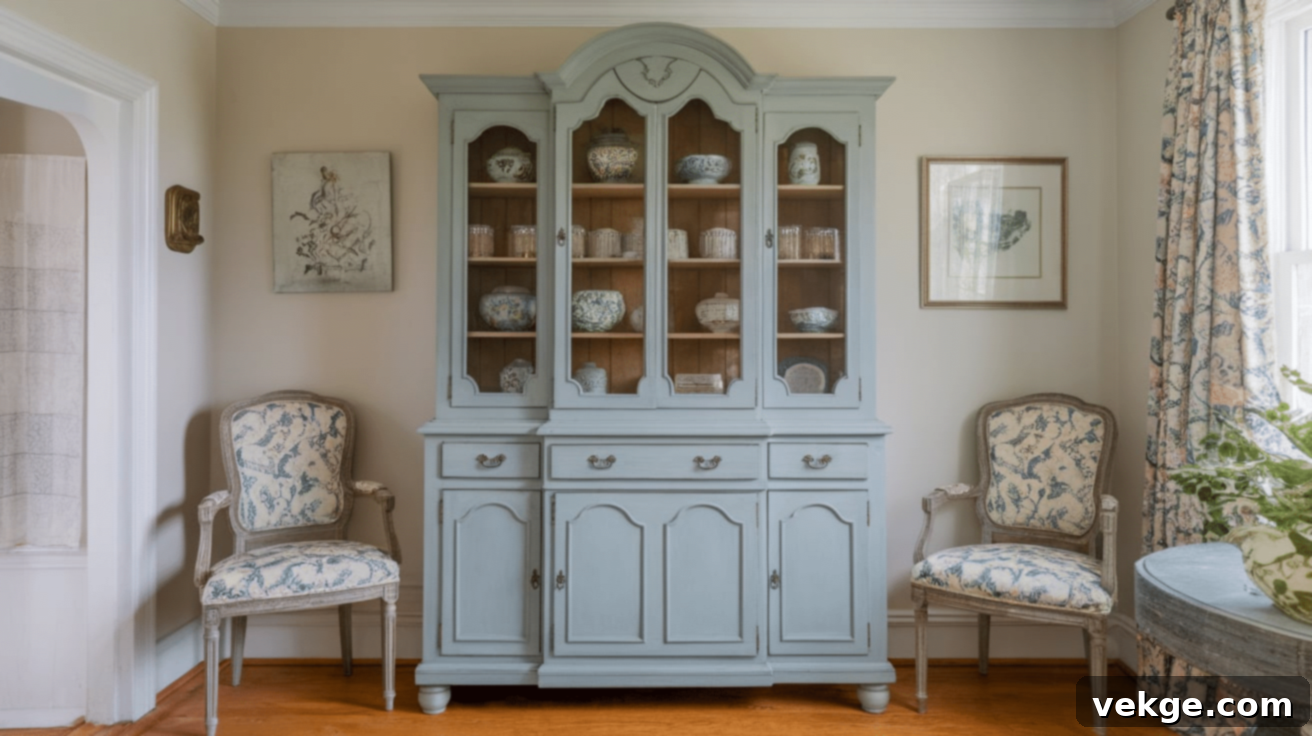
Chalk paint remains an immensely popular choice for furniture makeovers, largely due to its forgiving nature and the beautiful, soft, matte finish it produces. One of its greatest advantages is that it typically requires minimal surface preparation – often no priming or heavy sanding is needed, as it adheres exceptionally well to most surfaces. For optimal coverage and a smooth, even appearance, apply two thin coats, allowing each layer to dry completely. Once dry, seal the finish with a clear or tinted wax, which protects the paint and deepens its color, giving it a velvety touch. The unique quality of chalk paint often allows a subtle amount of the wood grain to peek through, adding a charming textured look that beautifully complements a wide range of home decor styles, from shabby chic to rustic modern, making it a favorite for DIY enthusiasts.
6. Bold & Bright Statement Piece

Dare to make your china cabinet the undeniable focal point of any room by embracing an unexpected palette of bright and bold colors. Imagine a vibrant deep blue, an emerald green, a sunny yellow, or even a striking crimson red transforming a traditionally demure piece into a dynamic work of art. For an extra layer of visual intrigue and ‘wow’ factor, paint the interior of the cabinet a contrasting or complementary color, creating a delightful surprise when the doors are opened. This audacious approach is particularly effective in homes with otherwise neutral color schemes, where the cabinet can truly stand out as a singular, artistic statement without competing with other elements, injecting personality, energy, and a playful spirit into your living space.
7. Elegant Glass and Mirror Accents
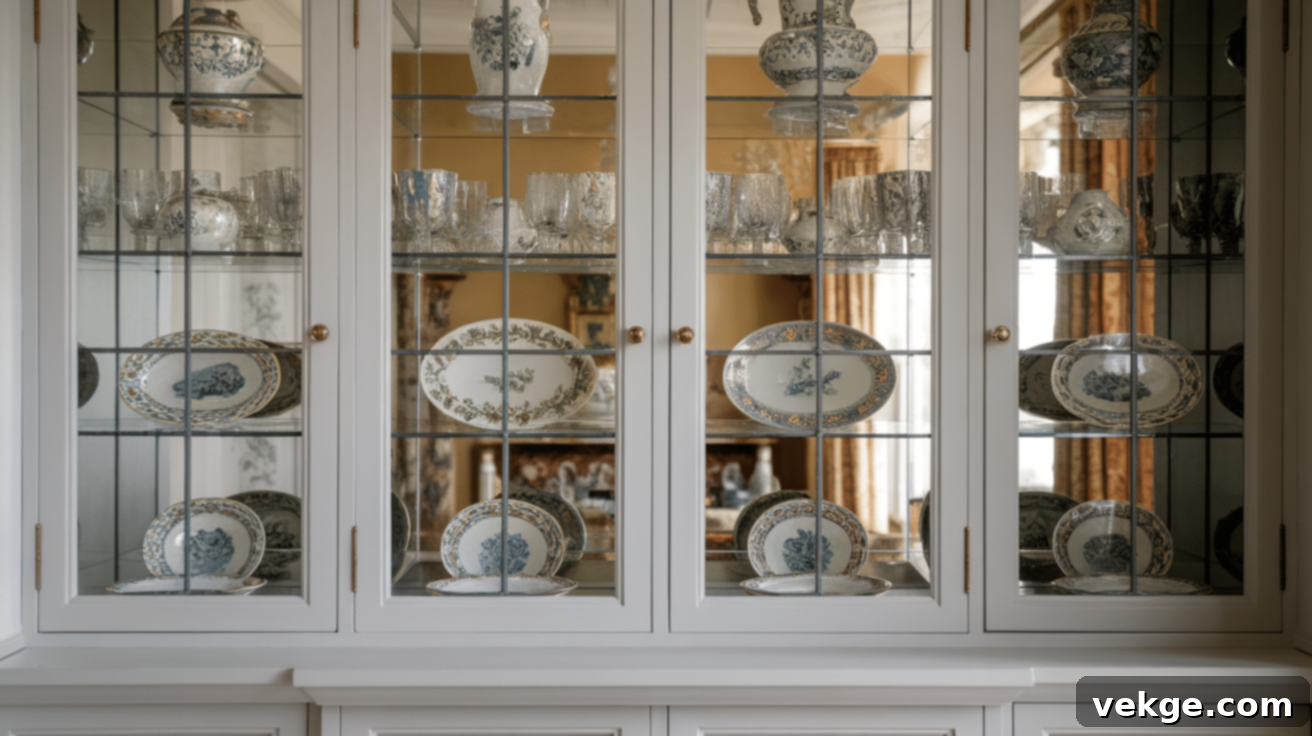
The strategic incorporation of glass or mirror inserts can profoundly alter both the visual weight and the overall ambiance of your china cabinet within a room. Replacing solid wood panels in doors or sides with clear glass will instantly lighten the cabinet’s appearance, making it feel less imposing and allowing the beauty of your displayed items to shine through. Alternatively, adding mirrored panels to the back of the cabinet or inside door panels can create an illusion of greater space, bounce natural light around the room, and beautifully reflect your curated collections. For a touch of sophistication and partial transparency, consider textured, fluted, or patterned glass, which provides visual interest while elegantly obscuring less attractive items stored within, all while still allowing light to filter through and brighten the interior.
8. Sleek Mid-Century Modern Revival
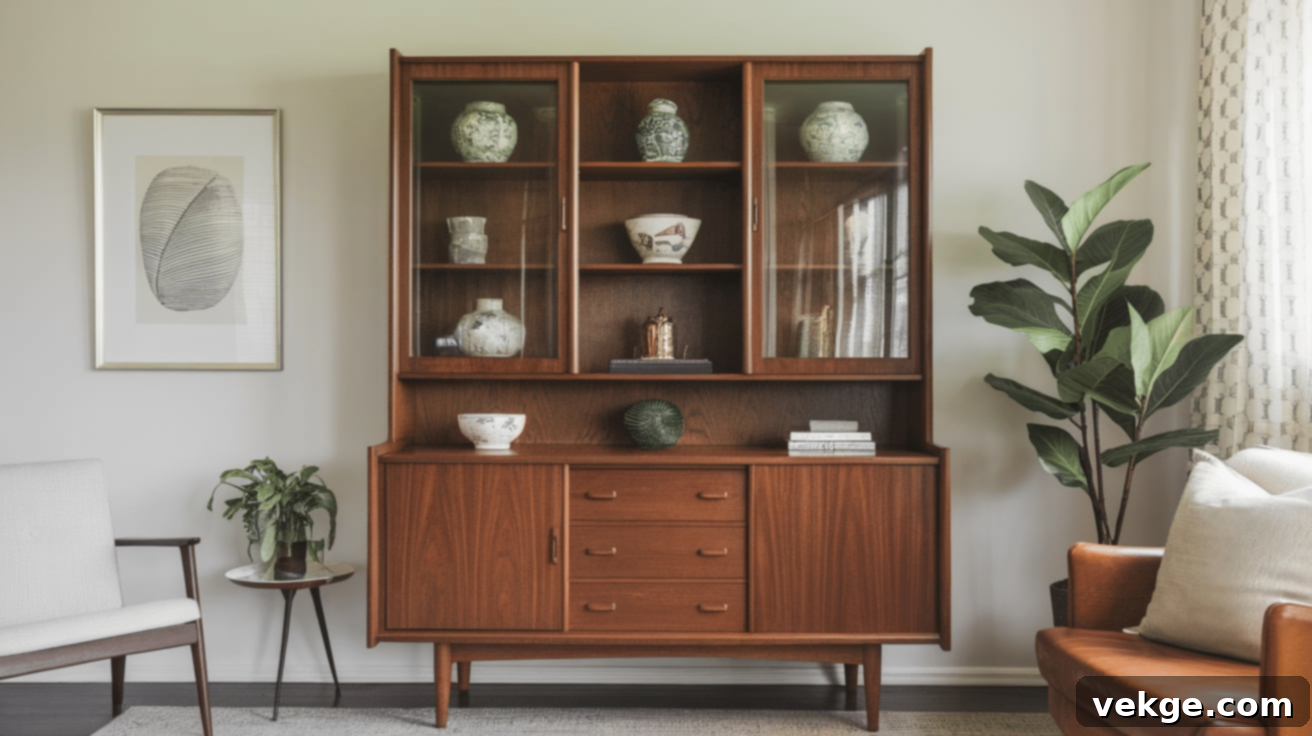
Many traditional china cabinets possess inherent clean lines that make them perfect candidates for a stylish mid-century modern transformation. To achieve this iconic look, meticulously strip away any old finishes to reveal the bare wood, then sand it flawlessly smooth. Apply a rich teak or walnut-toned stain to enhance the natural wood grain, and opt for a matte rather than a glossy topcoat to maintain the authentic mid-century aesthetic. Replace outdated hardware with simple, minimalist brass, chrome, or solid wood pulls, often set at clean, angular positions. If the cabinet design allows, consider tapering the existing legs or adding stylish hairpin legs or sleek, straight supports to elevate its profile. This sophisticated style works exceptionally well with cabinets featuring strong geometric forms and minimal ornamentation, embodying elegance and understated cool, making it a timeless addition.
9. Romantic Shabby Chic with Floral Wallpaper
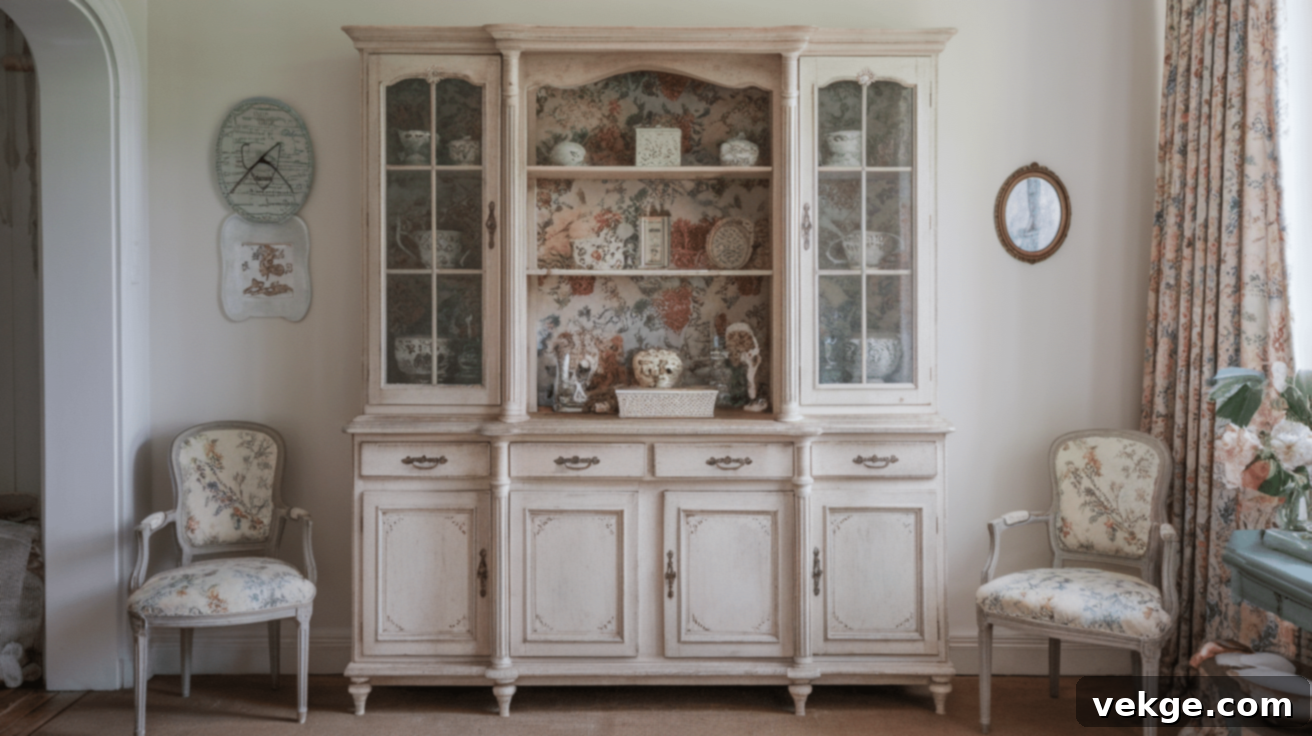
For a beautifully soft, romantic, and inviting aesthetic, consider a shabby chic makeover enhanced with charming floral wallpaper. Begin by carefully lining the interior back panels of your china cabinet with a delicate floral or toile patterned wallpaper, creating a stunning backdrop for your displayed items. For the cabinet’s exterior, choose a serene color palette of light cream, soft pastel shades (like mint green or dusty rose), or crisp white paint. After painting, gently distress the edges and corners with fine-grit sandpaper, allowing a subtle hint of the underlying wood or previous paint layers to show through, imparting a cherished, well-loved character. Complete the look with elegant glass knobs, ceramic pulls, or vintage-inspired brass hardware. This approach is perfectly suited for displaying antique tea sets, delicate cake stands, or other feminine kitchen and dining treasures, evoking a sense of nostalgic grace and charm.
10. Edgy Industrial Style Transformation

Give your traditional china cabinet a dramatic, urban edge with an industrial-style makeover. Start by painting the entire cabinet in a sophisticated dark gray, matte black, or deep charcoal. To enhance the raw, utilitarian aesthetic, add decorative metal corner braces, strapping, or exposed rivet details. Consider replacing traditional wooden shelves with industrial-inspired materials like perforated metal mesh, reclaimed wood planks, or even sturdy plumbing pipe shelving, creating an open and rugged feel. For hardware, repurpose actual plumbing pipe fittings for distinctive drawer pulls and door handles. This bold style pairs exceptionally well with exposed brick walls, concrete floors, and other raw, textural elements, forging an intriguing fusion of refined classic furniture shape with robust, factory-inspired touches, perfect for a modern loft or urban home.
11. Rustic Sliding Barn Door Integration
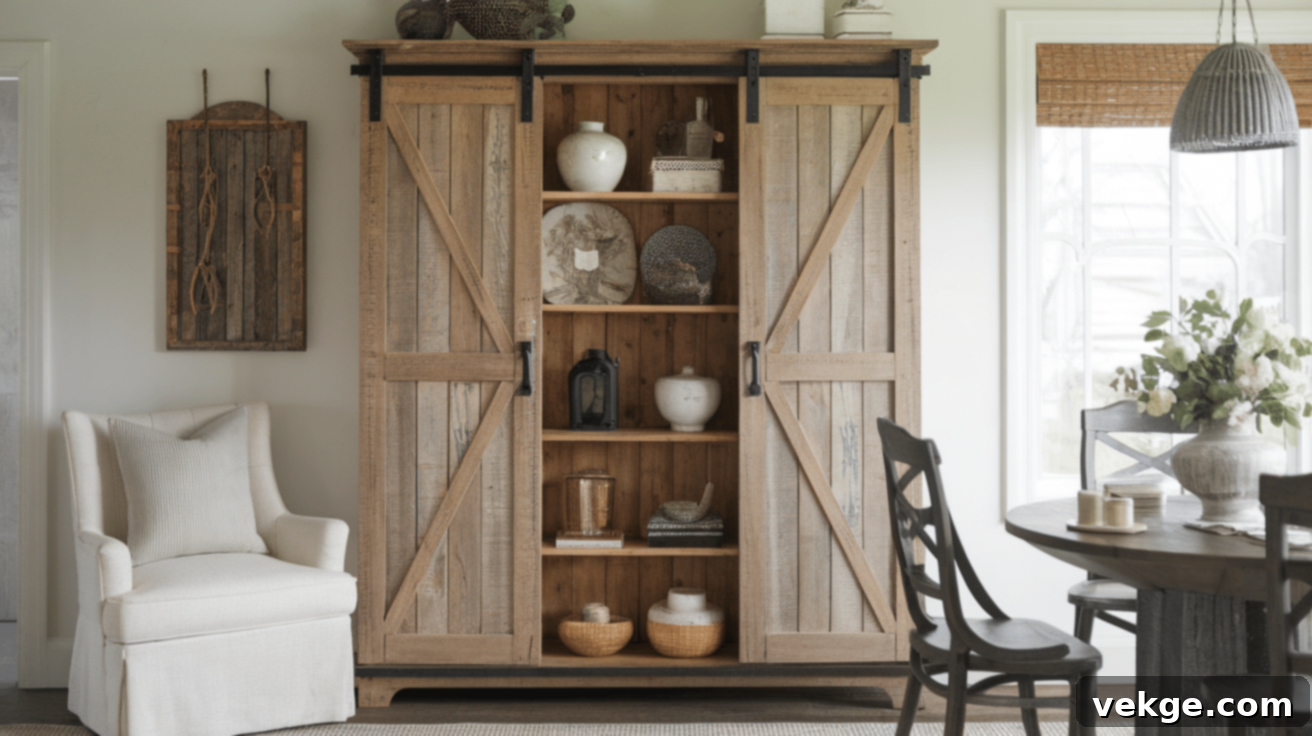
For a truly distinctive and functional style update, consider replacing the traditional swing-open doors of your china cabinet with charming sliding barn-style doors. This modification requires careful planning and the installation of a mini barn door track system mounted above the cabinet openings. Select reclaimed wood, distressed timber, or custom-built doors painted and aged to perfectly match a rustic farmhouse aesthetic. Complete the look with robust, dark metal handles reminiscent of authentic barn gate hardware. This clever adaptation not only injects significant character and a casual, country-inspired feel into your space but also maintains excellent functionality, especially effective for wider china cabinets where traditional doors might obstruct movement, offering a unique blend of style and practicality and making a strong visual statement.
12. Repurpose as a Stylish Bedroom Dresser
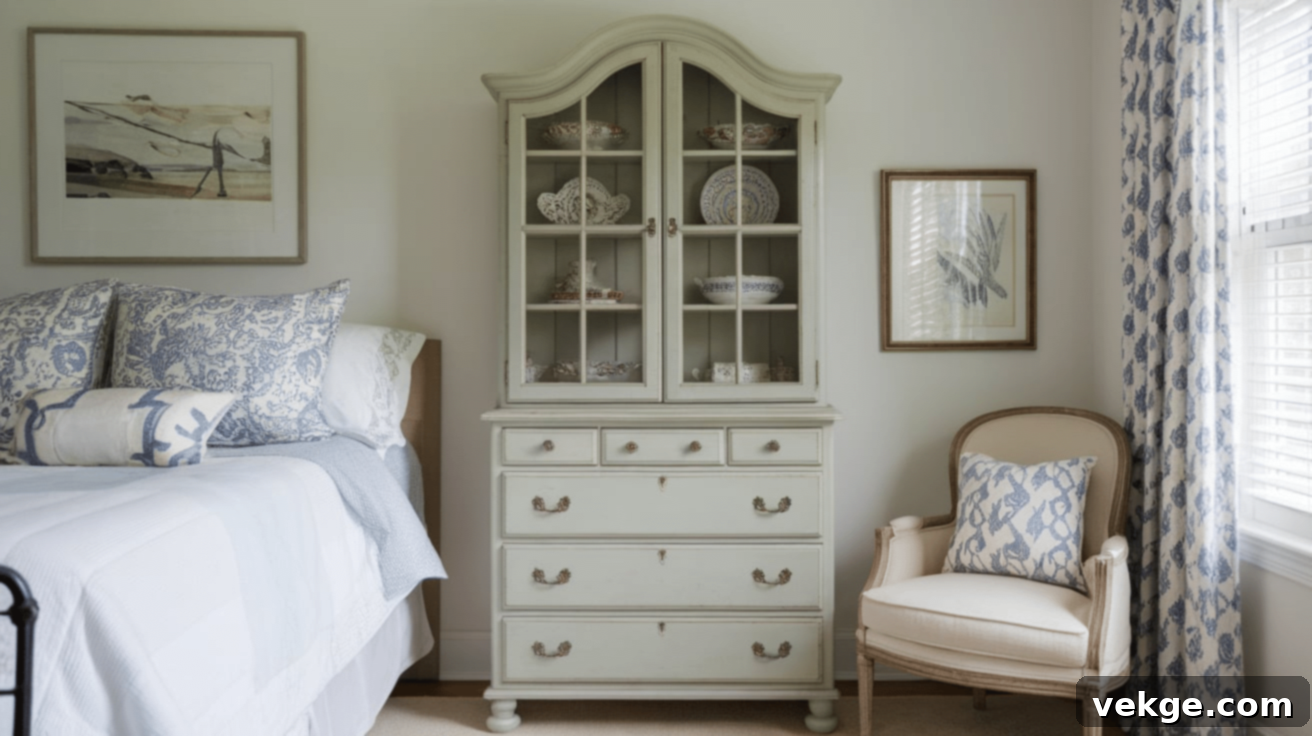
A china cabinet can provide an ingenious and elegant solution to storage challenges in a bedroom. The sturdy lower drawers are perfectly suited for neatly organizing clothing, while the captivating glass-front sections offer an exquisite opportunity to display cherished jewelry, elegant watches, perfumes, or other special personal items, turning them into decorative accents. Paint the cabinet in colors that beautifully complement your bedroom’s existing theme – perhaps a serene blue, a sophisticated grey, or a warm cream. For smaller items within the shelves, add fabric-lined baskets or decorative boxes to maintain an organized and clutter-free appearance. This creative repurposing offers a unique combination of practical storage and a distinctive visual appeal that truly sets it apart from standard bedroom furniture, adding character and personalized elegance to your private sanctuary.
13. Reimagined as a Pure Display Cabinet
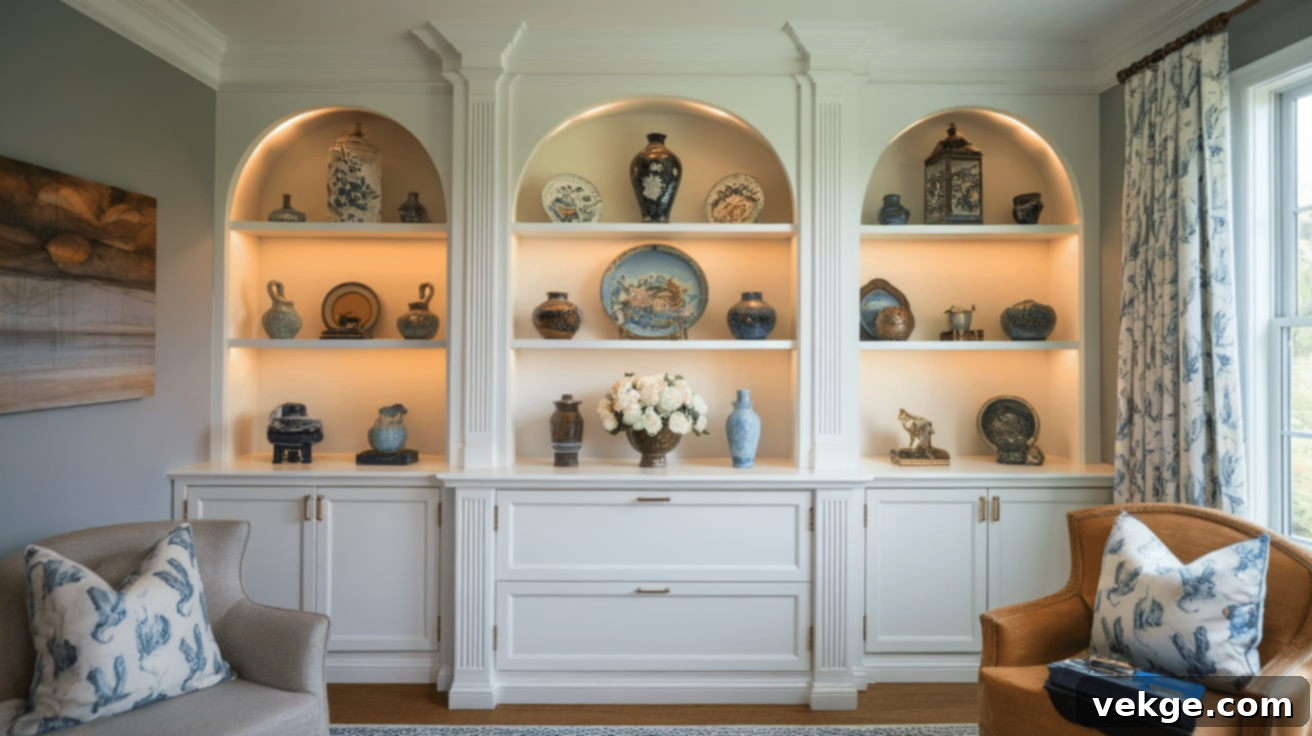
For some china cabinets, their true calling lies in serving as pure, unadulterated display pieces, showcasing beloved collections with grace and prominence. To achieve an expansive, open feel, consider removing the doors entirely, offering unobstructed views and easy access to your treasures. Paint the interior back panel and shelves in a color that vividly complements or provides a stunning contrast to your displayed items, making them truly pop and enhancing their visual impact. Enhance visibility and create a dramatic effect by adding subtle battery-powered LED puck lights or strip lighting discreetly under shelves or along the top interior. These add warmth and sophistication, drawing the eye to your curated collection. Arrange shelves at varying heights to perfectly accommodate items of different sizes, from towering books to delicate figurines. This approach is an absolute dream for avid book lovers, dedicated collectors, or anyone seeking to elegantly showcase special mementos and curated artifacts in a living room, study, or hallway, turning your cabinet into a personal museum.
Your Comprehensive Step-by-Step Guide to a DIY China Cabinet Makeover
Embarking on a DIY china cabinet makeover is an incredibly rewarding endeavor that combines creative expression with practical skill, all while being budget-friendly. This detailed guide breaks down the process into clear, manageable steps, ensuring that even novice DIYers can confidently transform their cabinet from an overlooked relic into a cherished centerpiece. Follow these instructions meticulously to achieve professional-looking results from start to finish.
Step 1: Thorough Preparation is Key
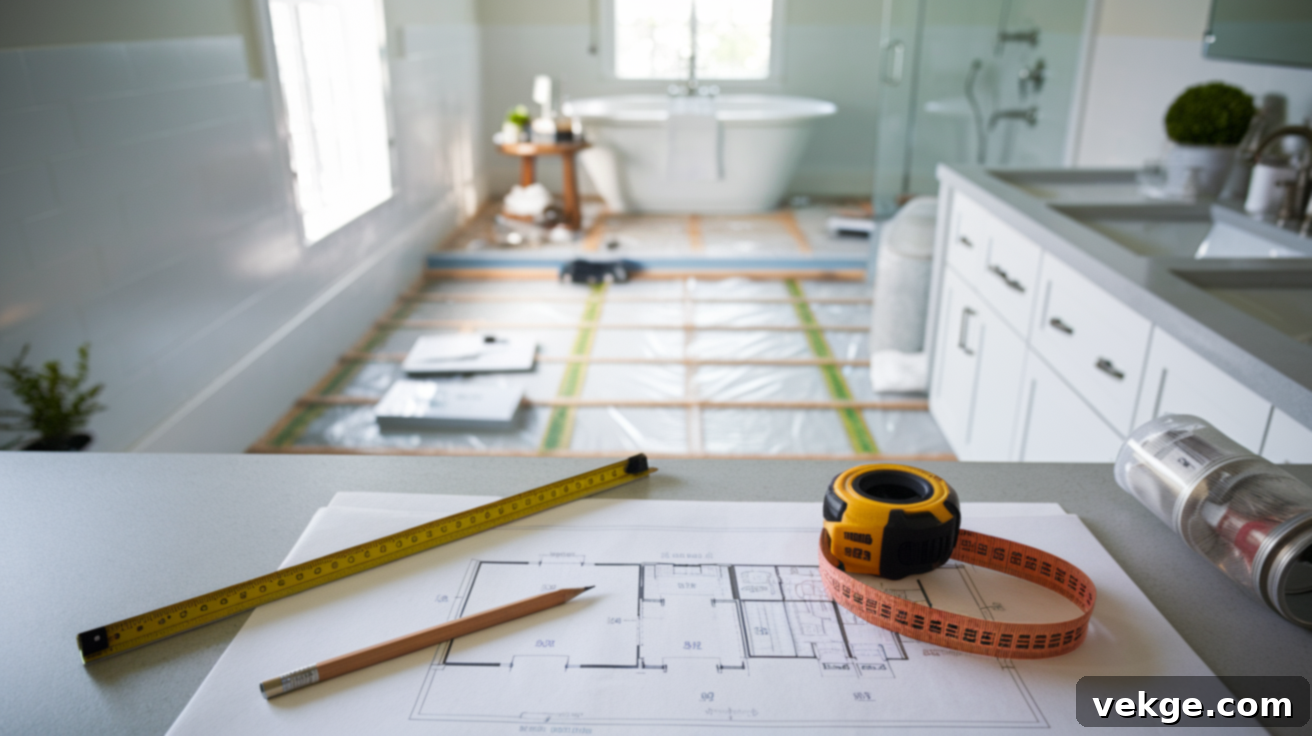
The success of any furniture makeover hinges on meticulous preparation. Begin by completely emptying the china cabinet of all contents. Next, carefully remove all doors, internal shelves, and any existing hardware such as knobs, pulls, and hinges. As you dismantle, use painter’s tape and a marker to label each piece (e.g., “top left door,” “middle shelf front,” “drawer 1”) and its corresponding location. This seemingly small step is crucial for making reassembly later on significantly easier and preventing frustrating alignment issues, especially with multiple doors and drawers.
Once disassembled, give the entire cabinet a thorough cleaning. Use a mild soap and water solution (like dish soap and water) to remove years of dust, dirt, grime, and grease buildup. For more stubborn stains or sticky residue, a specialized wood cleaner or a degreaser might be necessary. Rinse with a clean, damp cloth and allow the cabinet to dry completely – ideally for several hours or overnight – before proceeding. Finally, inspect for any imperfections. Fill all existing holes (if you plan to change hardware location), scratches, dents, or minor chips with a high-quality wood filler. Apply the filler, allow it to dry according to the product instructions, and then lightly sand it smooth with fine-grit sandpaper, ensuring a perfectly even surface for your chosen finish.
Step 2: Expert Sanding and Flawless Painting/Staining
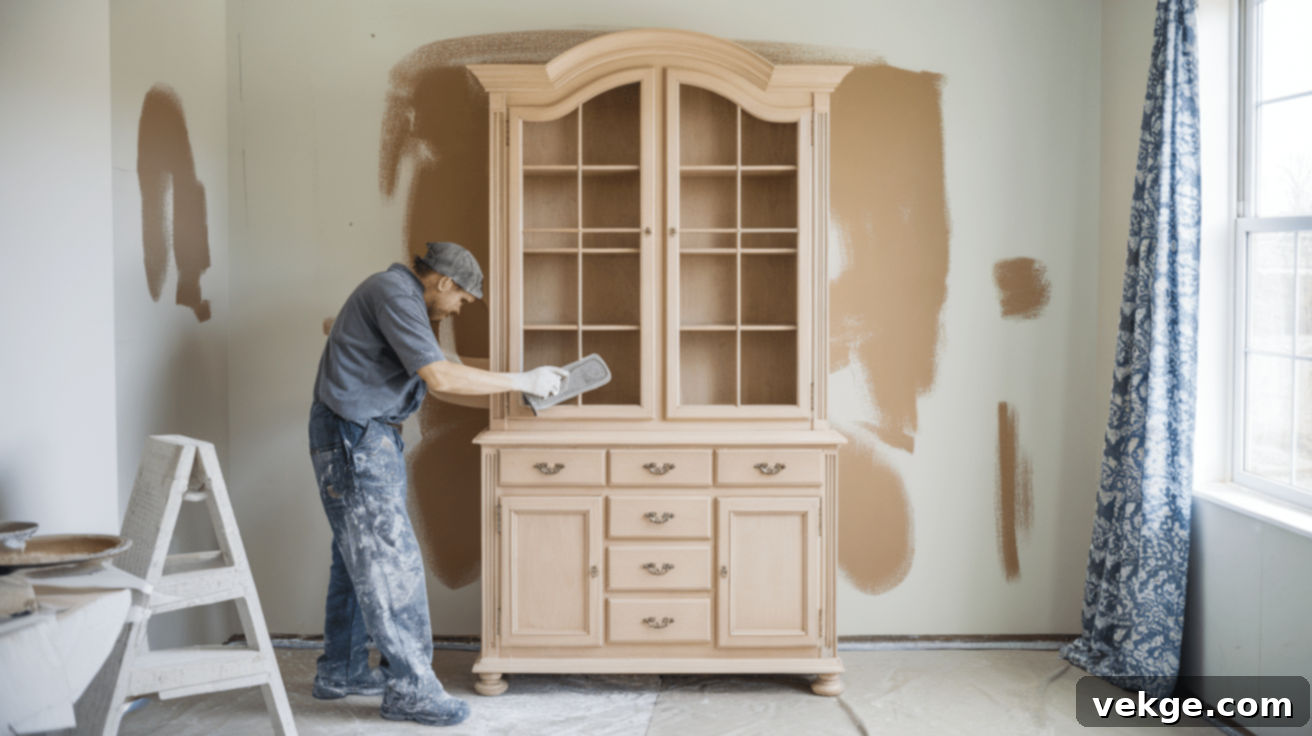
Sanding is a critical step that creates a surface for paint or stain to properly adhere, ensuring a durable and smooth finish. For painting, lightly sand all surfaces you intend to paint with a medium-grit sandpaper (120-150 grit). This process is not about stripping the old finish entirely (unless heavily damaged) but rather about creating a “tooth” for the new coating to grip onto. If you plan to stain the cabinet, you’ll need to strip the old finish completely using a chemical stripper or extensive sanding, and then sand with progressively finer grits of sandpaper (starting with 80-100 grit, then moving to 150, 180, and finally 220 grit) to achieve a perfectly smooth, uniform surface that will absorb the stain evenly and beautifully.
After sanding, use a vacuum cleaner with a brush attachment and then wipe away all residual dust meticulously thoroughly with a tack cloth or a damp (not wet) microfiber cloth. Allow the surface to dry completely. If you are painting, particularly when transitioning from a dark color to a lighter one, applying a high-quality primer is essential. Primer blocks stains, promotes adhesion, and ensures true color rendition. Apply thin, even coats of your chosen paint or stain. Use a good quality angled brush for detailed areas and corners, and a small foam roller for flat surfaces to minimize brush marks. Always allow adequate drying time between coats as recommended by the product manufacturer. Most projects will require at least 2-3 thin coats for optimal, even coverage and a beautiful, long-lasting result. Remember, patience in this step yields the most satisfying and professional outcome.
Step 3: Elevating with New Hardware
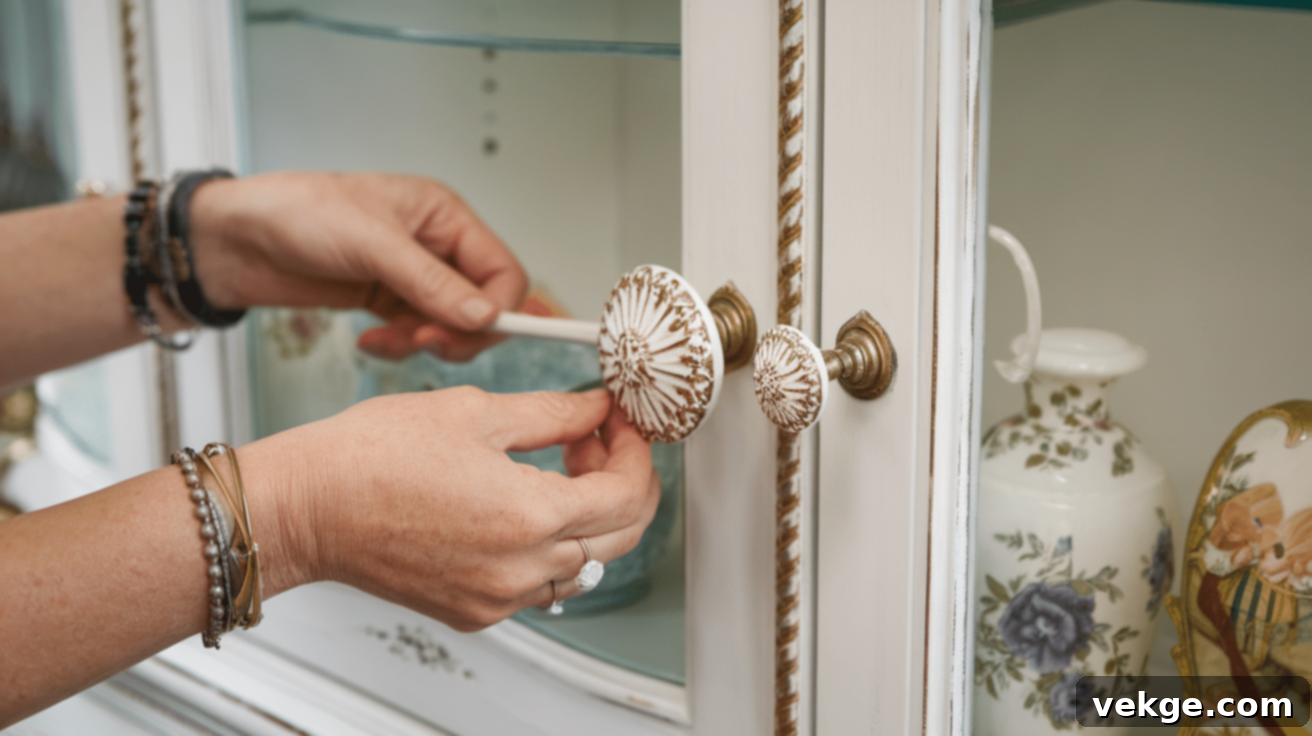
New hardware is often one of the most impactful yet simplest ways to dramatically refresh and modernize the entire aesthetic of your china cabinet. Before purchasing, carefully measure the distance between the existing screw holes on your doors and drawers if you wish to reuse them. If you’re creating new holes or changing the style significantly, use a hardware template or a ruler and pencil to ensure precise, straight alignment for all new knobs and pulls. The style of your chosen hardware should harmoniously complement your cabinet’s new look – opt for sleek, minimalist handles for a modern appeal, or intricate glass knobs and ornate pulls for a vintage or traditional style.
Consider the finish of the hardware as well: warm brass or gold tones can add a touch of luxury, while matte black hardware provides a striking, contemporary contrast against lighter cabinet colors. Brushed nickel offers a timeless, versatile option. Install your new hardware gently and carefully, ensuring not to scratch or chip your freshly painted or stained surfaces. A cordless drill with the correct bit will make the process quick and efficient, but always double-check measurements before drilling to avoid costly mistakes. This final, thoughtful touch will make your china cabinet feel custom, high-end, and perfectly aligned with its new identity.
Step 4: The Art of Finishing Touches

These crucial final details are what truly elevate your china cabinet makeover from good to spectacular. Consider adding a decorative element to the back panel – wallpaper, contact paper with a unique pattern (like marble, wood grain, or a vibrant print), or even fabric can introduce a pop of color, texture, and unexpected charm. If your cabinet features glass panels, think about replacing plain glass with textured, reeded, or frosted options for added visual interest and a touch of privacy, or even adding mirror inserts for extra light and depth. To beautifully highlight your displayed items, install battery-powered LED puck lights or strip lighting discreetly under shelves or along the top interior. These add warmth and sophistication, drawing the eye to your curated collection.
Crucially, protect your hard work! Apply a clear protective finish, such as a durable polyurethane (for paint or stain), or furniture wax (especially for chalk paint). This topcoat guards against daily wear and tear, moisture, and scratches, ensuring the longevity and beauty of your makeover. Always follow the product’s instructions for application and drying times. Once everything is dry and protected, carefully reattach all shelves and doors, making any necessary hinge adjustments for perfect alignment. Step back, take “after” photos to compare with your “before” shots, and relish the immense satisfaction of transforming an old piece into a stunning, functional showpiece that reflects your unique style and enhances your home for years to come.
Troubleshooting Common Problems in Your China Cabinet Makeover
Even the most seasoned DIY enthusiasts can encounter hurdles during a furniture makeover project. Being prepared with solutions to common issues can be a game-changer, preventing frustration and helping you achieve the polished, professional-looking results you desire. Don’t let these minor setbacks derail your project; a little know-how goes a long way in ensuring a successful china cabinet transformation.
- Uneven Sanding / Rough Patches: If you notice rough or uneven areas after initial sanding or painting, gently re-sand the problematic spots with very fine-grit sandpaper (220-320 grit). Wipe the surface meticulously clean to remove all dust, then apply another thin, even coat of paint or finish. Patience is key to a smooth, professional finish.
- Visible Brush Marks or Streaks: These often occur from applying paint too thickly or using a poor-quality brush. To rectify, lightly sand the affected areas smooth with fine-grit paper (e.g., 220 grit) between coats. Always use high-quality synthetic brushes for water-based paints and natural bristle brushes for oil-based paints, applying thin, even layers. A foam roller can also help minimize marks on flat surfaces, leaving a smoother appearance.
- Unsightly Paint Drips or Runs: Drips typically happen when too much paint is applied in one go. Apply paint in thinner coats and consistently monitor for drips as you work, immediately wiping them away with your brush before they dry. If dried drips occur, carefully sand them smooth with fine-grit sandpaper, feathering the edges, then clean the area and touch up with a thin coat of paint.
- Wobbly or Unstable Shelves: If shelves feel insecure, start by checking the shelf pins; ensure they are fully seated and undamaged. For added stability, consider replacing standard plastic shelf pins with sturdier metal versions or reinforcing the shelves with small L-brackets or cleats screwed into the cabinet sides. Ensure shelves are perfectly level before securing them to prevent items from sliding or falling.
- Sticky or Sticking Drawers: This common issue can be due to accumulated grime, humidity swelling the wood, or worn runners. First, clean the drawer runners and cabinet tracks thoroughly. Apply a thin layer of paste wax, paraffin wax, or even a dry bar of soap to the contact points of the wooden runners to reduce friction. If swelling is the culprit, gently sand down the affected areas of the drawer or tracks until they slide smoothly.
- Misaligned or Sagging Doors: Doors that don’t close properly or hang unevenly can usually be adjusted at the hinges. Loosen the screws on the hinge plates slightly (both on the door and on the cabinet frame). Gently reposition the door to achieve proper alignment and then retighten the screws firmly. For severely warped doors, you might need to consult a woodworking professional or consider replacing the door entirely.
- Paint Peeling or Chipping: Peeling paint indicates poor adhesion, likely due to inadequate surface preparation (e.g., not cleaning or sanding properly). To fix, sand the affected area back to a solid, well-adhered surface, ensuring all loose paint is removed. Clean thoroughly, apply a good quality primer to the bare spots, and then repaint, ensuring thin, even coats and proper drying times for optimal adhesion.
Conclusion: Embrace the Transformation!
Bringing an old china cabinet back to life through a thoughtful makeover is an immensely fulfilling project that beautifully marries creative vision with practical application. Far from being just another piece of furniture, your newly updated cabinet has the potential to become a truly stunning focal point in your home, perfectly reflecting your personal style and intelligently addressing your evolving storage or display needs.
Remember, the magnitude of the transformation doesn’t always correlate with the effort involved. Sometimes, the simplest changes—like a vibrant new coat of paint, elegant modern hardware, or a strategically placed wallpaper accent—are all it takes to elevate a forgotten piece into a cherished heirloom or a contemporary showstopper. Whether you opt for a dramatic color shift, a clever repurpose for a modern utility, or a subtle refresh of its classic charm, the satisfaction you’ll derive from your china cabinet makeover will be a constant source of joy and pride, a testament to your creativity and effort.
Don’t let that dormant piece sit unused any longer. Take the decisive first step today, gather your inspiration, and begin the journey. Your future showpiece is eagerly waiting to be revealed, ready to add character, functionality, and undeniable style to your living space. Happy making!
Frequently Asked Questions About China Cabinet Makeovers
Can I paint over an existing stained or varnished china cabinet?
Absolutely! With the right preparation, you can successfully paint over virtually any stained or varnished china cabinet. The key steps include thorough cleaning to remove grease and grime, light sanding to create a surface for the paint to adhere to, and then applying a high-quality primer. Once primed, your cabinet is ready for your chosen paint color, ensuring a fresh, durable, and beautiful new look.
What type of paint is best for a durable china cabinet makeover?
For optimal durability and a beautiful finish, several paint types work well. Chalk paint is very popular due to its minimal prep requirements and matte finish, which should always be sealed with wax or a clear topcoat for protection. High-quality furniture paints (such as acrylic latex or even oil-based enamels for extreme durability) are also excellent choices. Look for paints specifically formulated for cabinets or furniture, as these are designed to withstand more wear and tear and offer a long-lasting finish.
What are some budget-friendly ways to update a china cabinet without a full overhaul?
You don’t need to spend a fortune to make a big impact. Some highly effective, budget-friendly updates include simply replacing outdated hardware (knobs, pulls, hinges) with modern or vintage-inspired pieces. Applying decorative contact paper or peel-and-stick wallpaper to the back panel or inside shelves can add significant pattern and color. A simple paint refresh in a new, contemporary color can also work wonders without requiring extensive stripping or repair. Consider adding LED strip lights for ambiance or swapping out plain glass for a textured option to elevate the look economically.
How long does a typical china cabinet makeover take?
The duration of a china cabinet makeover largely depends on the complexity of your chosen design and your DIY experience. A simple paint and hardware refresh might take one to two weekends, allowing for adequate drying times between coats and finishes. More intricate projects involving structural changes (like adding barn doors), extensive repairs, or multiple finishing techniques could extend to several weekends or even a full week of dedicated work. Planning ahead and having all your materials ready will significantly help streamline the process and reduce overall time.
Is painting a china cabinet difficult for a beginner?
Not at all! Painting a china cabinet is a fantastic project for beginners. The most crucial part is proper preparation (cleaning and light sanding), which is straightforward. Using beginner-friendly paints like chalk paint can further simplify the process as they often require minimal priming. By following a step-by-step guide, taking your time, and applying thin coats, even a novice can achieve a beautiful and satisfying transformation, gaining valuable DIY experience along the way.
